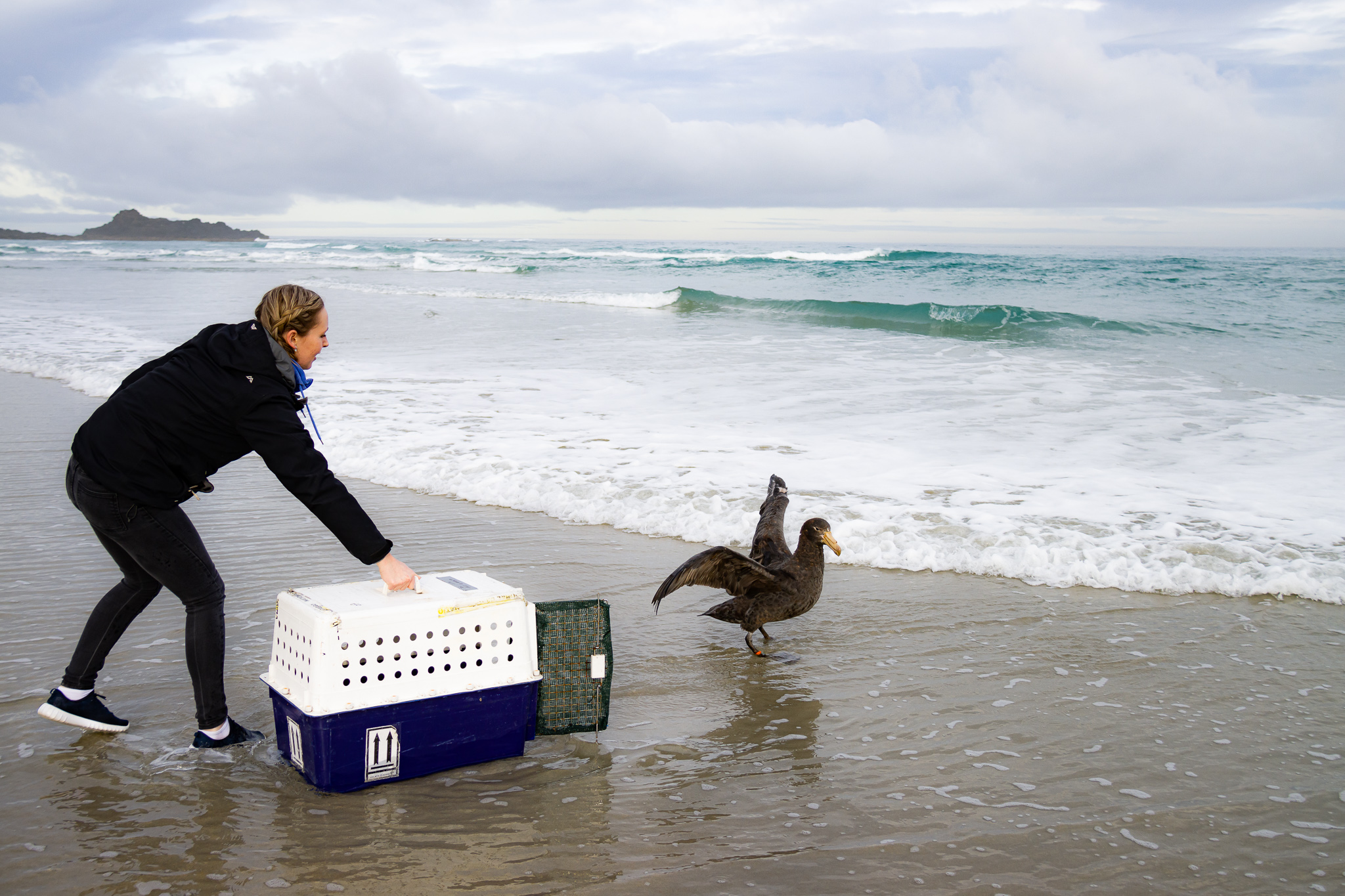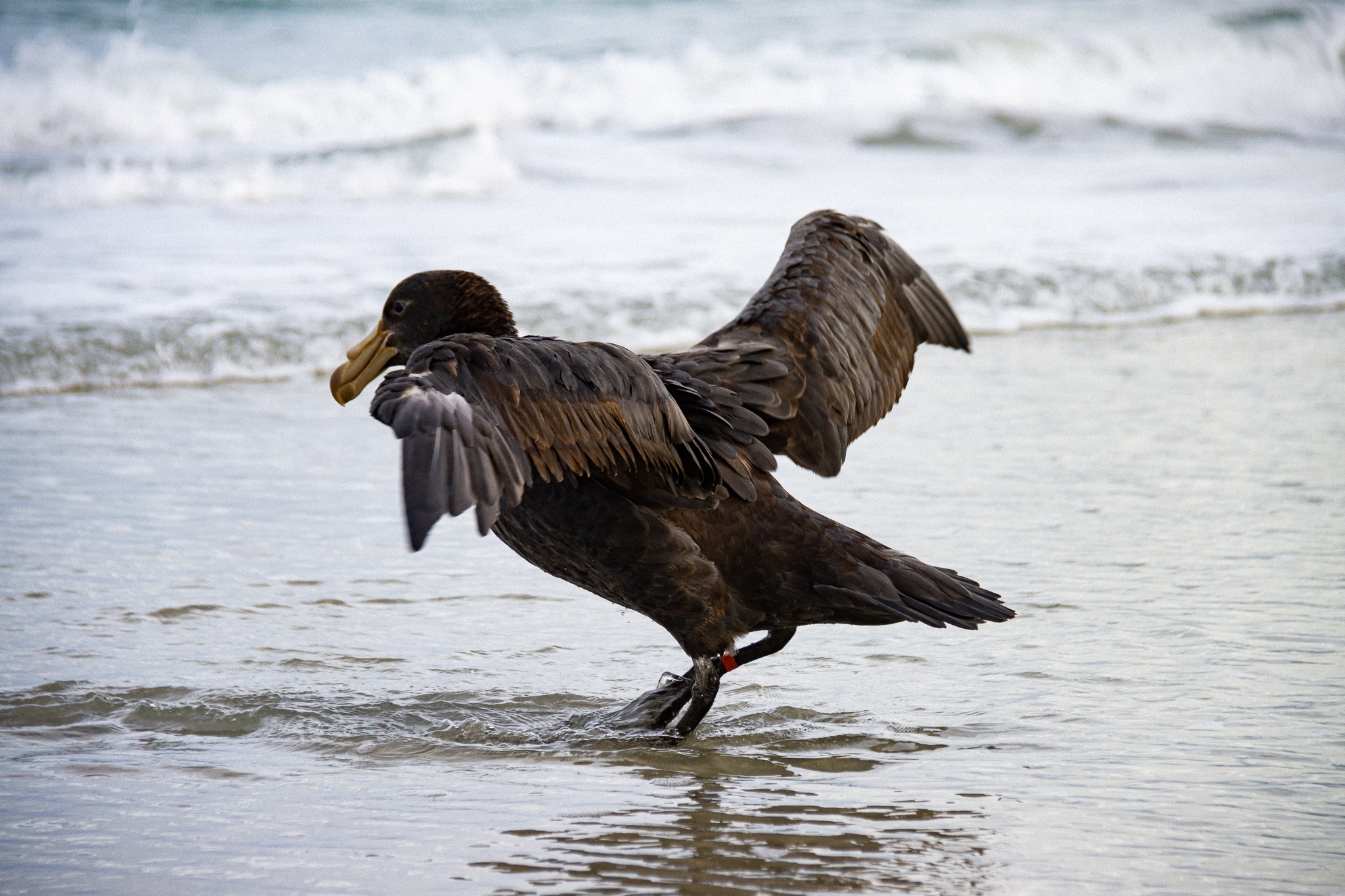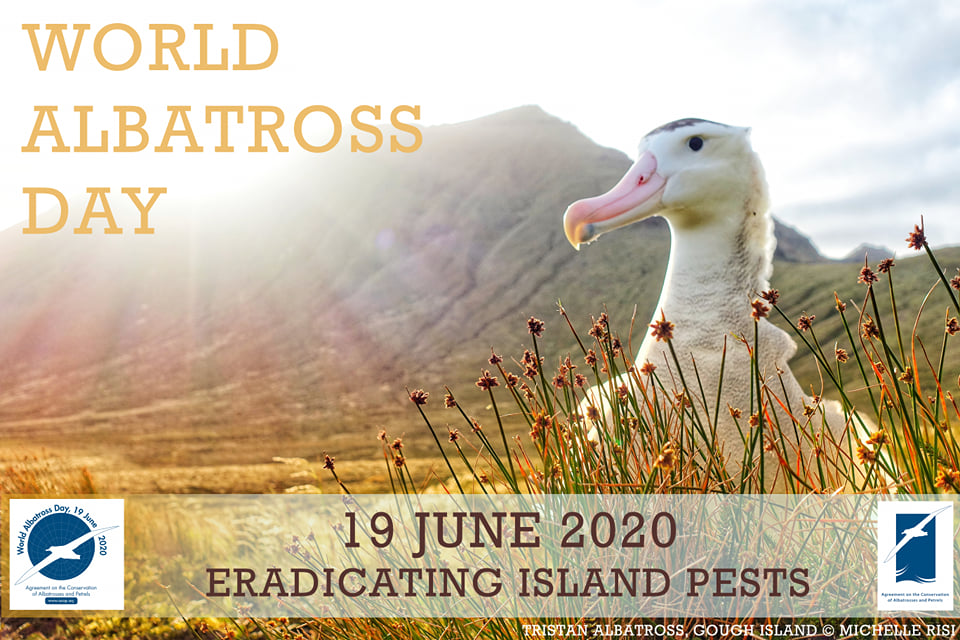
Alexis Osborne checks a non-breeding Wandering Albatross for bands under permit on Marion Island, photograph by Peter Ryan
Alexis Osborne, recently awarded the degree of Master of Science for his study of moult in albatrosses and giant petrels, writes to ACAP Latest News:
“I started my journey to my first sub-Antarctic island in 2014 not knowing that this was going to be the start of big things. As a young boy growing up in the arid Northern Cape Province of South Africa, I never dreamt of travelling at sea for days on end, let alone living on islands for a part of my life. My first voyage was to Marion Island where I spent a year and where I also fell in love with seabirds. I started collecting data while on Marion for an Honours project which I started upon my return to South Africa. During 2017 I was fortunate to return to Marion Island, but also visited Gough Island and later that year Antarctica as well for their takeover periods. During my visit to Gough Island I knew immediately I wanted to stay for longer and when the opportunity presented itself in 2018 to return to Gough Island for a year, I grabbed it with both hands, not knowing I would be staying for two years. I recently finished my degree of Master of Science in Biological Sciences at the University of Cape Town’s FitzPatrick Institute of African Ornithology. I am currently still living on Gough Island and enjoying every moment but also looking forward to returning to South Africa.”

Photographing a Wanderer wing at Marion Island, photograph by Kim Stevens
The thesis abstract follows:
“Moult is an energetically demanding process for birds, and the replacement of flight feathers impacts flight performance. As a result, few birds overlap moult with other key activities such as breeding or migrating. Feather growth rates show little change in relation to body size, so large birds with long flight feathers take a long time to grow individual feathers, making their moult even more challenging. Unless these birds can afford to become flightless for several weeks while they replace all their flight feathers simultaneously, many large birds lack sufficient time to breed and replace all their wing feathers each year. As a result, they have evolved complex moult strategies that replace a subset of feathers each year. Albatrosses and giant petrels are prime examples of birds facing this challenge. This study focusses on Wandering Albatrosses (Diomedea exulans) and Northern Giant Petrels (Macronectes halli) breeding at Marion Island and Southern Giant Petrels (M. giganteus) at Gough Island. I explore primary and secondary moult patterns in Wandering Albatrosses and secondary and greater secondary coverts in giant petrels in relation to breeding activity.
I used digital photography to record the wear patterns in the wings of Wandering Albatrosses and giant petrels. Using photographs of upperwings of marked individuals over time allowed the opportunity to track changes in the wear pattern among specific feathers, although scoring feather wear from images works better for darker feathers. The rate of wear among secondaries and their coverts differed across the wing, with the inner feathers wearing faster than the central feathers. Photographing the extended wings of albatrosses and petrels incubating eggs had no impact on hatching success. Using this method I was able to test the often held assumption that wing feather moult is largely symmetrical. In Wandering Albatrosses, moult symmetry was greatest in outer flight feathers, especially primaries. However, the pattern of increasing asymmetry towards the body was not consistent; inner primaries showed less symmetry than outer secondaries and inner secondaries were moulted with greater symmetry than central secondaries. Giant petrels preferentially replaced the inner and outer secondaries and the inner and outer greater secondary coverts, and feather symmetry was greatest in these feathers. All three species indicated some asymmetry in all feathers that had an incomplete annual moult. Depending on the question being asked, I recommend scoring both wings when investigating moult patterns.
Wandering Albatrosses typically take a sabbatical year following a successful breeding attempt, and thus failed breeders usually have less time to moult between successive breeding attempts. Following a successful breeding attempt, Wandering Albatrosses from Marion Island replaced a similar number of primary feathers on average (males 7.9 and females 7.3) as birds from the Crozet Islands (males 8.8 and females 8.1) and South Georgia (males 8.6 and females 7.1). Wandering Albatrosses that do not skip a year following a failed breeding attempt, not only replaced fewer feathers on average, but showed a difference in number of feathers replaced between sexes at Marion Island (males 7.4, females 6.1), as previously reported at the Crozet Islands (males 8.3, females 6.5) and South Georgia (males 7.2, females 5.2). These results suggest that females are under greatest pressure when a breeding attempt fails. Because females from South Georgia replace fewer feathers, especially following a failed breeding attempt, they might be under more stress than females from populations breeding at islands in the Indian Ocean (Marion and Crozet). This parallels the contrasting population trends in these regions, with numbers increasing over the last few decades in the Indian Ocean (Marion and Crozet Islands) but decreasing steadily at South Georgia. General Linear Models (GLMs) showed that sex and time available to moult both influenced the number and mass of flight feathers replaced. Sex explained more variation in terms of number of feathers replaced (67%) than time available to moult (33%), but time available to moult explained 68% of the mass of flight feathers replaced. However, there is large variation among birds in the number of primaries and secodaries replaced, independent of time available for moult. Together, sex and time available to moult accounted for only 9.2% (number) and 11.9% (mass) of the variance in feathers replaced.
Giant petrels are one of the largest birds that undergo a complete primary moult each year without losing the ability to fly. They do this by overlapping their moult with breeding and by moulting several primaries at once. Being annual breeders, individuals that fail a breeding attempt have more time to moult than successful breeders, and therefore replaced more flight feathers. Northern Giant Petrels having a successful breeding attempt replaced on average the same percentage of secondary and greater secondary coverts in both sexes; Following a successful breeding attempt Southern Giant Petrels (both sexes) replaced more feathers (secondaries and greater secondary coverts) than Northern Giant Petrels. I found that in a failed breeding attempt giant petrels have more time to moult and therefore replaced more secondary feathers than successful breeders. GLMs showed that breeding outcome was the only variable that influenced the mass of feathers replaced in Northern Giant Petrels, accounting for 14% of the variance in feathers replaced, while sex was the only variable in Southern Giant Petrels, accounting for 6% of variance. When both species were modelled together with sex and breeding attempt as explanatory variales, only breeding attempt was significant, accounting for 11% of the variance in the mass of secondaries and coverts replaced.
In summary, the assumption that breeding activity, and thus the time between breeding attempts, influences the extent of moult in large birds with incomplete wing moults was supported for Wandering Albatrosses and Northern Giant Petrels. However, time available for moult explained only a small proportion of individual variation in moult extent in these species. Southern Giant Petrels replaced a similar mass of flight feathers, irrespective of breeding outcome. My results suggest that factors other than time between breeding attempts are important in determining the extent of wing moult.
My study highlights the important tradeoffs large birds are required to make when balancing moult and reproduction. Annual monitoring of moult patterns in known individuals provides a valuable tool to better understand moult patterns in these large, long-lived birds.”
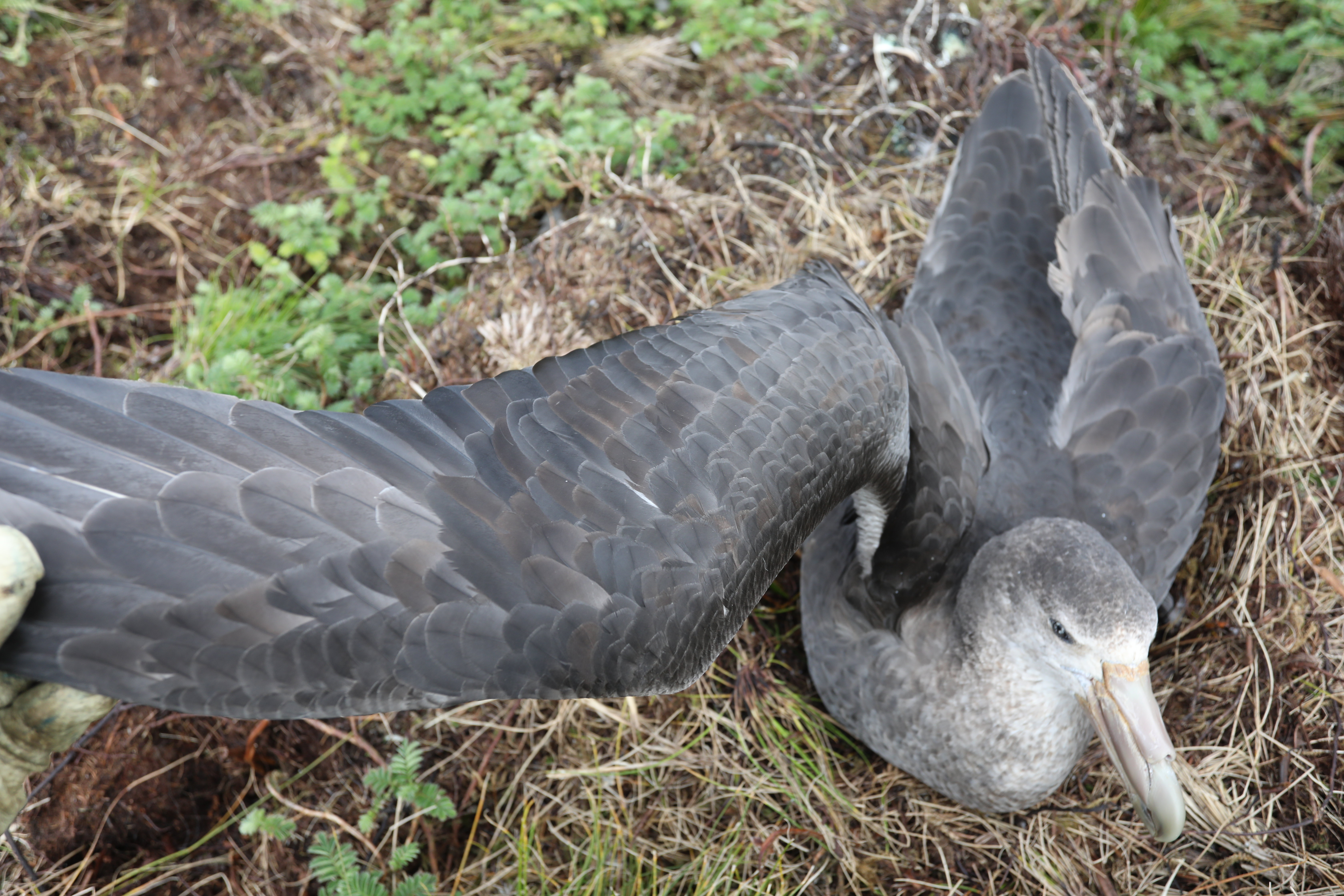
A Southern Giant Petrel on its nest on Gough Island, photograph by Peter Ryan
With thanks to Alexis Osborne.
Reference:
Osborne, A. 2020. Understanding Moult Patterns in Albatrosses and Petrels breeding on Marion and Gough Islands. MSc thesis. Department of Biological Sciences, University of Cape Town. 82 pp.
NOTE: the thesis will be available online after Alexis officially graduates later this year.
John Cooper, ACAP Information Officer, 13 July 2020
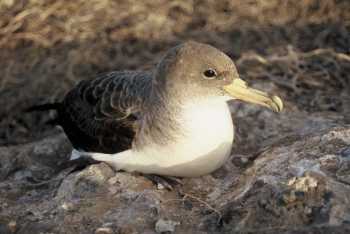

 English
English  Français
Français  Español
Español 


